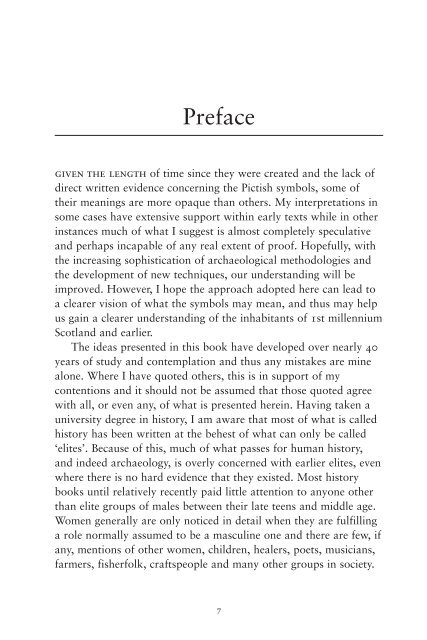Pagan Symbols of the Picts by Stuart McHardy sampler
Stuart McHardy examines the Pictish symbols which have been discovered on various items across Scotland. The book sets out a cohesive interpretation of the Pictish past, using a variety of both temporal and geographical sources. This interpretation serves as a backdrop for his analysis of the symbols themselves, providing a context for his suggestion that there was an underlying series of ideas and beliefs behind the creation of the symbols.
Stuart McHardy examines the Pictish symbols which have been discovered on various items across Scotland. The book sets out a cohesive interpretation of the Pictish past, using a variety of both temporal and geographical sources. This interpretation serves as a backdrop for his analysis of the symbols themselves, providing a context for his suggestion that there was an underlying series of ideas and beliefs behind the creation of the symbols.
Create successful ePaper yourself
Turn your PDF publications into a flip-book with our unique Google optimized e-Paper software.
Preface<br />
given <strong>the</strong> length <strong>of</strong> time since <strong>the</strong>y were created and <strong>the</strong> lack <strong>of</strong><br />
direct written evidence concerning <strong>the</strong> Pictish symbols, some <strong>of</strong><br />
<strong>the</strong>ir meanings are more opaque than o<strong>the</strong>rs. My interpretations in<br />
some cases have extensive support within early texts while in o<strong>the</strong>r<br />
instances much <strong>of</strong> what I suggest is almost completely speculative<br />
and perhaps incapable <strong>of</strong> any real extent <strong>of</strong> pro<strong>of</strong>. Hopefully, with<br />
<strong>the</strong> increasing sophistication <strong>of</strong> archaeological methodologies and<br />
<strong>the</strong> development <strong>of</strong> new techniques, our under standing will be<br />
improved. However, I hope <strong>the</strong> approach adopted here can lead to<br />
a clearer vision <strong>of</strong> what <strong>the</strong> symbols may mean, and thus may help<br />
us gain a clearer understanding <strong>of</strong> <strong>the</strong> inhabitants <strong>of</strong> 1st millennium<br />
Scotland and earlier.<br />
The ideas presented in this book have developed over nearly 40<br />
years <strong>of</strong> study and contemplation and thus any mistakes are mine<br />
alone. Where I have quoted o<strong>the</strong>rs, this is in support <strong>of</strong> my<br />
contentions and it should not be assumed that those quoted agree<br />
with all, or even any, <strong>of</strong> what is presented herein. Having taken a<br />
university degree in history, I am aware that most <strong>of</strong> what is called<br />
history has been written at <strong>the</strong> behest <strong>of</strong> what can only be called<br />
‘elites’. Because <strong>of</strong> this, much <strong>of</strong> what passes for human history,<br />
and indeed archaeology, is overly concerned with earlier elites, even<br />
where <strong>the</strong>re is no hard evidence that <strong>the</strong>y existed. Most history<br />
books until relatively recently paid little attention to anyone o<strong>the</strong>r<br />
than elite groups <strong>of</strong> males between <strong>the</strong>ir late teens and middle age.<br />
Women generally are only noticed in detail when <strong>the</strong>y are fulfilling<br />
a role normally assumed to be a masculine one and <strong>the</strong>re are few, if<br />
any, mentions <strong>of</strong> o<strong>the</strong>r women, children, healers, poets, musicians,<br />
farmers, fisherfolk, craftspeople and many o<strong>the</strong>r groups in society.<br />
7


















